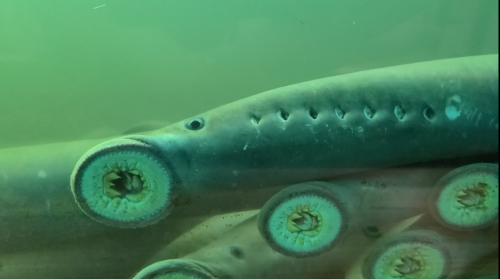Pacific lamprey returns eclipsing other years
Published 5:30 am Monday, October 2, 2023

- Pacific lampreys July 6, 2023, pass through the Bradford Island Visitor’s Center at Bonneville Lock & Dam on the Columbia River. The lampreys this year are returning at 170% higher than the 10-year average at Bonneville.
PORTLAND — Pacific lamprey, an ancient, eel-like fish species, are returning 170% higher than the 10-year average at Bonneville Lock and Dam.
The Army Corps of Engineers in a press release Friday, Sept. 29, lamprey numbers also are 252% higher than the four-year average, according to biologists responsible for reporting the number of fish counted as they migrate upstream past mainstem Columbia and Snake River dams.
Trending
Fish counters tallied 63,863 lampreys moving through the fish ladders during the daytime at Bonneville as of Sept. 18. The 10-year average daytime fish ladder count total is 41,414, if also counting this year’s run.
According to the final numbers from the 2022 Annual Fish Passage Report, which references completed counts more than 10 years from 2013-2022, the 10-year-average is 37,425. Corps of Engineers biologists are optimistic about the numbers they’re seeing.
“We have seen some improvements in lamprey passage success at some dams, thanks to ongoing efforts to modify fishways to make them more “lamprey friendly,” said Sean Tackley, a Northwestern Division, Fish Policy and Program manager. “Our tribal and federal partners have been critical in helping us make these improvements, and the tribes continue to lead lamprey restoration efforts throughout the Columbia Basin.”
The Columbia River Inter-Tribal Commission notes the fish, “provided an important source of food for the tribes of the Columbia River Basin, who prized them for their rich, fatty meat. They were served alongside salmon at tribal feasts and celebrations.”
Lamprey are very active at night and pass via special ramp-like lamprey passage structures, so daytime counts are just minimum estimates. Additionally, tribal biologists collect many lampreys at Bonneville for upstream transport to tributaries such as the Umatilla, Clearwater and Yakama rivers. Corps of Engineer staff estimate the actual total number of lampreys passing the dam this year is probably closer to 165,314.
“Although we’re encouraged by this year’s numbers, we know a lot of this is driven by ocean conditions and food availability in the Pacific Ocean,” according to Tackley. “These kinds of years motivate us all to continue to do what we can to help these important fish.”
Trending
Since the 1990s, the Corps has used funding to study lamprey passage behavior, develop new and effective passage structures and modify fish ladders at the eight lower Columbia and lower Snake River dams so they work for both salmon and lamprey. These efforts have included tribes and several other federal agencies:
• CRITFC conducts translocations, genetic monitoring, Hood River natural recolonization, artificial propagation and contaminant accumulation.
• The Bonneville Power Administration funds translocation programs for tribal partners, lamprey specific passage improvements, artificial propagation research and other important research, monitoring and evaluation programs.
• The U.S. Fish and Wildlife Service works with tribal, state and federal partners to conserve Pacific lamprey through the Pacific Lamprey Conservation Initiative by assessing population status and threats; conducting and funding research, monitoring and restoration actions; facilitating and participating in technical, management, and policy forums; and advocating for Pacific lamprey as a cultural and ecologically critical species through outreach and education.
So far, most of the Army Corps of Engineers work has focused on fixing adult lamprey passage at the dams, but agency biologists also are studying downstream passage of juvenile and larval lamprey at the dams so they can better understand how operations and structures may affect passage and survival of these life stages.









